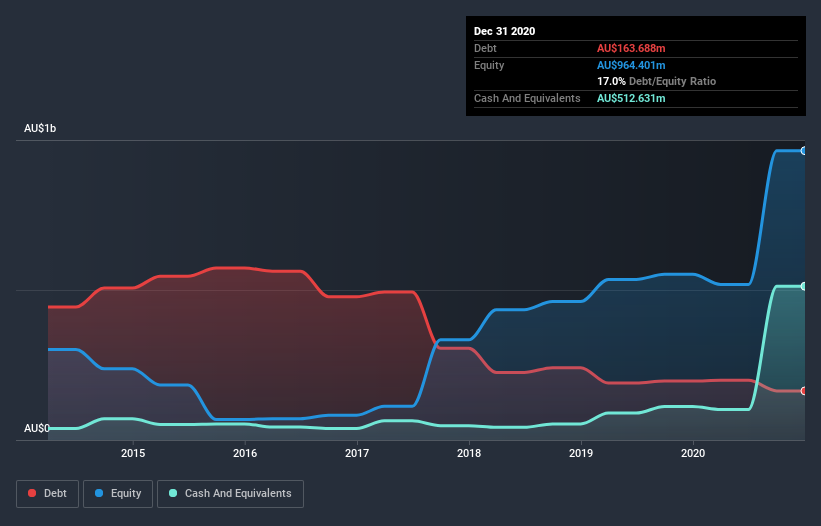We Think Lynas Rare Earths (ASX:LYC) Can Stay On Top Of Its Debt
Some say volatility, rather than debt, is the best way to think about risk as an investor, but Warren Buffett famously said that 'Volatility is far from synonymous with risk.' So it seems the smart money knows that debt - which is usually involved in bankruptcies - is a very important factor, when you assess how risky a company is. As with many other companies Lynas Rare Earths Limited (ASX:LYC) makes use of debt. But should shareholders be worried about its use of debt?
What Risk Does Debt Bring?
Debt is a tool to help businesses grow, but if a business is incapable of paying off its lenders, then it exists at their mercy. Part and parcel of capitalism is the process of 'creative destruction' where failed businesses are mercilessly liquidated by their bankers. However, a more common (but still painful) scenario is that it has to raise new equity capital at a low price, thus permanently diluting shareholders. Of course, the upside of debt is that it often represents cheap capital, especially when it replaces dilution in a company with the ability to reinvest at high rates of return. The first thing to do when considering how much debt a business uses is to look at its cash and debt together.
See our latest analysis for Lynas Rare Earths
What Is Lynas Rare Earths's Debt?
The image below, which you can click on for greater detail, shows that Lynas Rare Earths had debt of AU$163.7m at the end of December 2020, a reduction from AU$196.5m over a year. But it also has AU$512.6m in cash to offset that, meaning it has AU$348.9m net cash.
How Strong Is Lynas Rare Earths' Balance Sheet?
Zooming in on the latest balance sheet data, we can see that Lynas Rare Earths had liabilities of AU$76.6m due within 12 months and liabilities of AU$301.9m due beyond that. Offsetting these obligations, it had cash of AU$512.6m as well as receivables valued at AU$58.0m due within 12 months. So it actually has AU$192.2m more liquid assets than total liabilities.
This surplus suggests that Lynas Rare Earths has a conservative balance sheet, and could probably eliminate its debt without much difficulty. Simply put, the fact that Lynas Rare Earths has more cash than debt is arguably a good indication that it can manage its debt safely.
Shareholders should be aware that Lynas Rare Earths's EBIT was down 57% last year. If that decline continues then paying off debt will be harder than selling foie gras at a vegan convention. When analysing debt levels, the balance sheet is the obvious place to start. But ultimately the future profitability of the business will decide if Lynas Rare Earths can strengthen its balance sheet over time. So if you want to see what the professionals think, you might find this free report on analyst profit forecasts to be interesting.
Finally, a business needs free cash flow to pay off debt; accounting profits just don't cut it. Lynas Rare Earths may have net cash on the balance sheet, but it is still interesting to look at how well the business converts its earnings before interest and tax (EBIT) to free cash flow, because that will influence both its need for, and its capacity to manage debt. Happily for any shareholders, Lynas Rare Earths actually produced more free cash flow than EBIT over the last three years. There's nothing better than incoming cash when it comes to staying in your lenders' good graces.
Summing up
While it is always sensible to investigate a company's debt, in this case Lynas Rare Earths has AU$348.9m in net cash and a decent-looking balance sheet. And it impressed us with free cash flow of -AU$3.7m, being 122% of its EBIT. So we are not troubled with Lynas Rare Earths's debt use. The balance sheet is clearly the area to focus on when you are analysing debt. But ultimately, every company can contain risks that exist outside of the balance sheet. Case in point: We've spotted 4 warning signs for Lynas Rare Earths you should be aware of.
If you're interested in investing in businesses that can grow profits without the burden of debt, then check out this free list of growing businesses that have net cash on the balance sheet.
This article by Simply Wall St is general in nature. It does not constitute a recommendation to buy or sell any stock, and does not take account of your objectives, or your financial situation. We aim to bring you long-term focused analysis driven by fundamental data. Note that our analysis may not factor in the latest price-sensitive company announcements or qualitative material. Simply Wall St has no position in any stocks mentioned.
Have feedback on this article? Concerned about the content? Get in touch with us directly. Alternatively, email editorial-team (at) simplywallst.com.

 Yahoo Finance
Yahoo Finance 
